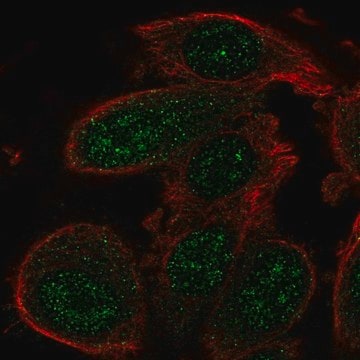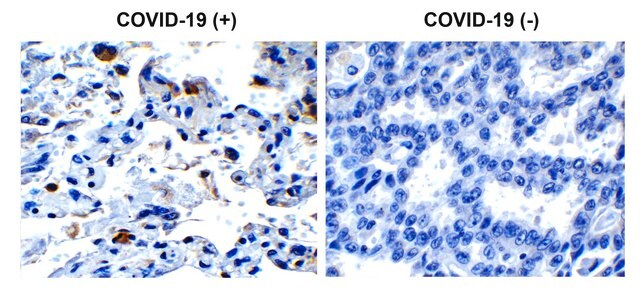MABT1323
Anti-Cdh1 Antibody, clone AR38.2
clone AR38.2, from mouse
Synonym(s):
Fizzy-related protein homolog, Fzr, Cdh1/Hct1 homolog
Sign Into View Organizational & Contract Pricing
All Photos(1)
About This Item
UNSPSC Code:
12352203
eCl@ss:
32160702
NACRES:
NA.41
Recommended Products
biological source
mouse
antibody form
purified antibody
antibody product type
primary antibodies
clone
AR38.2, monoclonal
species reactivity
human, mouse
packaging
antibody small pack of 25 μL
technique(s)
western blot: suitable
isotype
IgG1κ
NCBI accession no.
UniProt accession no.
target post-translational modification
unmodified
Gene Information
human ... CDH1(999)
General description
Fizzy-related protein homolog (UniProt: Q9R1K5; also known as Fzr, Cdh1/Hct1 homolog) is encoded by the Fzr1 (also known as Fyr, Fzr) gene (Gene ID: 56371) in murine species. Cdh1 is a substrate-specific adapter for the anaphase promoting complex/cyclosome (APC/C) E3 ubiquitin-protein ligase complex that associates with the APC/C in late mitosis, in replacement of CDC20, and activates the APC/C during anaphase and telophase. APC/C is activated upon sequential binding to the Cdc20 and Cdh1 adaptor proteins. Cdc20 associates with APC/C during early mitosis and principally regulates mitotic progression, while Cdh1 interacts with the APC/C from late mitosis onwards until the following G1/S transition. The APC/C remains active in degrading substrates to ensure that positive regulators of the cell cycle do not accumulate prematurely. At the G1/S transition Cdh1 is phosphorylated, leading to its dissociation from the APC/C. It has been shown that Cdk-mediated Cdh1 phosphorylation prevents Cdh1 from associating with APC/C prematurely during S/G2 phase, while CDC14B phosphatase-dependent APC/C-Cdh1 activation in response to DNA damage during G2 phase leads to ubiquitination and degradation of Polo-like kinase 1 (Plk1) and prevents entry into mitosis. Following DNA repair, Cdk1 and Plk1 are reactivated and cell cycle progresses from G2 into mitosis phase.
Specificity
Clone AR38.2 detects Cdh1 (Fizzy-related protein homolog) in human and mouse cells.
Immunogen
His-tagged full-length recombinant mouse Fizzy-related protein homolog (Cdh1).
Application
Anti-Cdh1, clone AR38, Cat. No. MABT1323, is a mouse monoclonal antibody that detects Cdh1/FZR1 and has been tested for use in Western Blotting.
Western Blotting Analysis: A representative lot detected Cdh1 in Western Blotting applications (Garzon, J., et. al. (2017). Oncogene. 36(42):5808-5818).
Quality
Evaluated by Western Blotting in HeLa cell lysate.
Western Blotting Analysis: A 1:500 dilution of this antibody detected Cdh1 in HeLa cell lysate.
Western Blotting Analysis: A 1:500 dilution of this antibody detected Cdh1 in HeLa cell lysate.
Target description
~54 kDa observed; 54.69 kDa calculated. Uncharacterized bands may be observed in some lysate(s).
Physical form
Format: Purified
Other Notes
Concentration: Please refer to lot specific datasheet.
Not finding the right product?
Try our Product Selector Tool.
Certificates of Analysis (COA)
Search for Certificates of Analysis (COA) by entering the products Lot/Batch Number. Lot and Batch Numbers can be found on a product’s label following the words ‘Lot’ or ‘Batch’.
Already Own This Product?
Find documentation for the products that you have recently purchased in the Document Library.
Sahezeel Awadia et al.
The Journal of biological chemistry, 299(6), 104786-104786 (2023-05-06)
The E3 ubiquitin ligase APC/C-Cdh1 maintains the G0/G1 state, and its inactivation is required for cell cycle entry. We reveal a novel role for Fas-associated protein with death domain (FADD) in the cell cycle through its function as an inhibitor
Our team of scientists has experience in all areas of research including Life Science, Material Science, Chemical Synthesis, Chromatography, Analytical and many others.
Contact Technical Service








